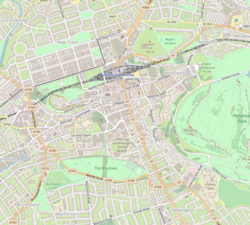St. Giles' Cathedral
| St Giles' Cathedral | |
|---|---|
| High Kirk of Edinburgh | |

St Giles, west façade
|
|
| Coordinates: 55°56′58″N 3°11′27″W / 55.94944°N 3.19083°W | |
| Location | Royal Mile, Edinburgh |
| Country | Scotland |
| Denomination | Church of Scotland |
| Previous denomination | Roman Catholic |
| Website | www.stgilescathedral.org.uk |
| History | |
| Founded | 12th century |
| Dedication | Saint Giles |
| Past bishop(s) | Bishop of Edinburgh |
| Architecture | |
| Status | Parish church |
| Functional status | Active |
| Heritage designation | Category A listed building |
| Designated | 14 December 1970 |
| Administration | |
| Presbytery | Edinburgh |
| Clergy | |
| Minister(s) | Reverend Calum MacLeod |
|
Listed Building – Category A
|
|
| Official name: High Street and Parliament Square, St Giles (High) Kirk | |
| Designated | 14 December 1970 |
| Reference no. | 27381 |
St Giles' Cathedral, also known as the High Kirk of Edinburgh, is the principal place of worship of the Church of Scotland in Edinburgh. Its distinctive crown steeple is a prominent feature of the city skyline, at about a third of the way down the Royal Mile which runs from the Castle to Holyrood Palace. The church has been one of Edinburgh's religious focal points for approximately 900 years. The present church dates from the late 14th century, though it was extensively restored in the 19th century, and is protected as a category A listed building. Today it is sometimes regarded as the "Mother Church of Presbyterianism". The cathedral is dedicated to Saint Giles, who is the patron saint of Edinburgh, as well as of cripples and lepers, and was a very popular saint in the Middle Ages. It is the Church of Scotland parish church for part of Edinburgh's Old Town.
St Giles' was only a cathedral in its formal sense (i.e. the seat of a bishop) for two periods during the 17th century (1635–1638 and 1661–1689), when episcopalianism, backed by the Crown, briefly gained ascendancy within the Kirk (see Bishops' Wars). In the mediaeval period, prior to the Reformation, Edinburgh had no cathedral as it was under the jurisdiction of the Bishop of St Andrews, whose episcopal seat was St Andrews Cathedral. For most of its post-Reformation history the Church of Scotland has not had bishops, dioceses, or cathedrals. As such, the use of the term cathedral today carries no practical meaning. The "High Kirk" title is older, being attested well before the building's brief period as a cathedral.
...
Wikipedia

